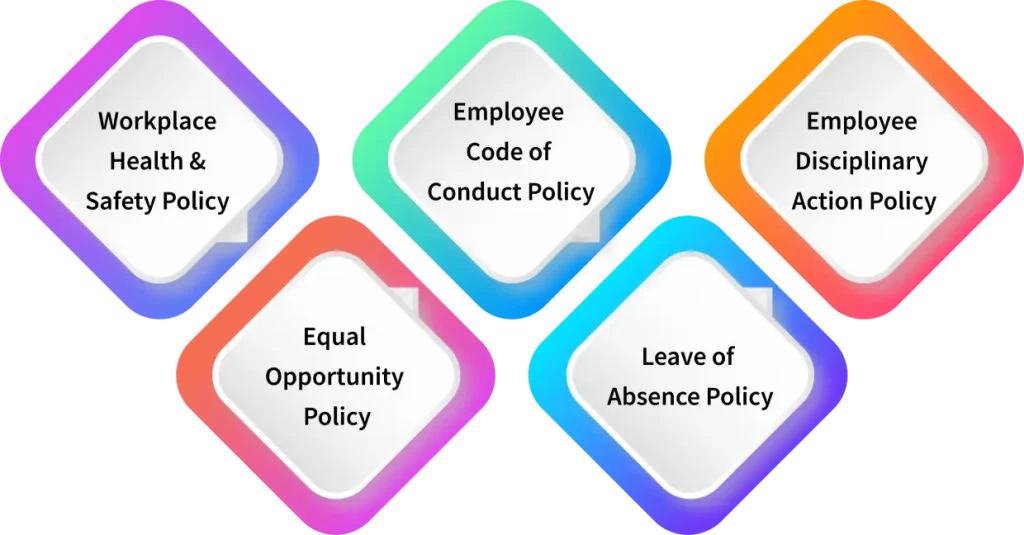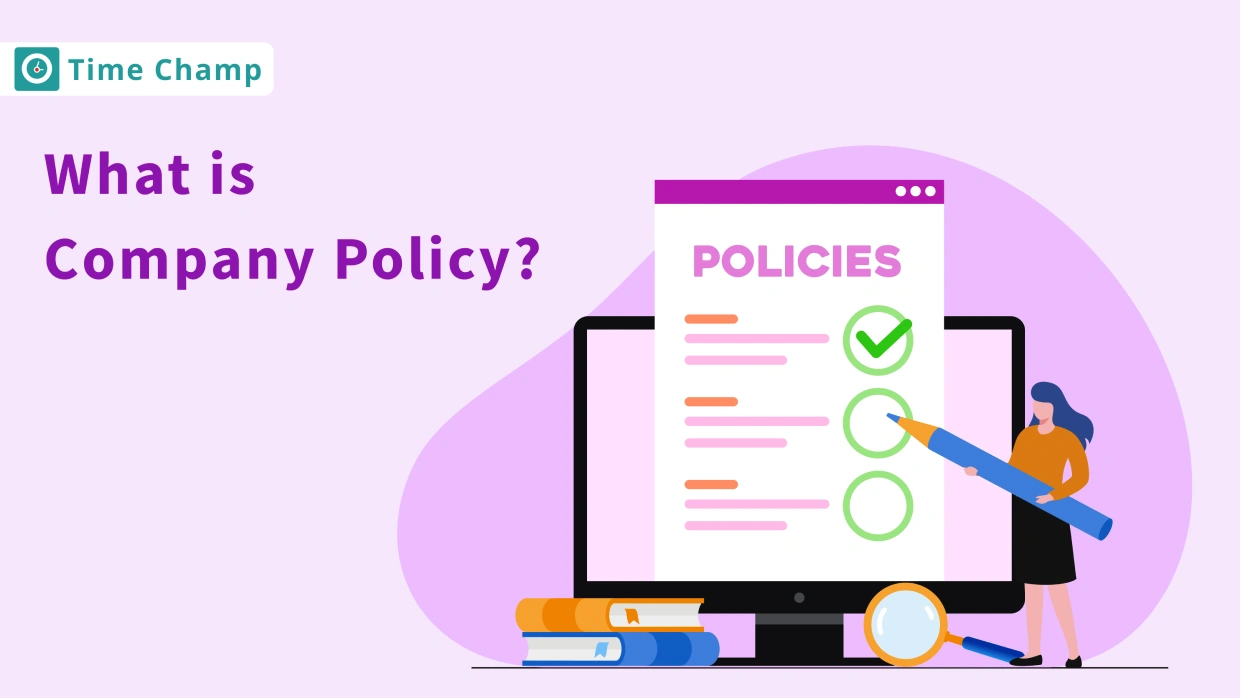What is Company Policy?
A company policy is a set of guidelines, rules, and principles an organization establishes to ensure consistency, fairness, and compliance among employees. These company policies provide a framework for how employees should act and make decisions in various workplace situations. They cover workplace behavior, health and safety, attendance, remote work, use of company resources, confidentiality, and more.
Why are Company Policies Important?
Company policies are important for several reasons. They help everyone in the company understand the rules. Here are some simple reasons why these policies matter:
1. Guidance for Employees
A company policy gives employees clear instructions on what they should do. This includes rules about how to behave, when to work, and how to treat each other. When everyone knows the rules, it makes the workplace better.
2. Fairness in Decisions
Policies help make sure that decisions are fair and consistent. This means that similar situations will be handled in the same way. When employees see fairness, they feel more secure and happy at work.
3. Protection for the Company
Clear policies can protect the company from legal problems. For example, rules about harassment or discrimination show that the company cares about these issues. This helps keep the company’s good name.
4. Better Communication
Policies improve communication in the company. When everyone knows the rules and procedures, there is less confusion. Employees know where to find information and who to ask if they have questions.
5. Support for Company Goals
Policies help everyone work towards the same goals of the company. They make sure that employee actions match the company’s mission and values. This leads to better teamwork and success.
6. Employee Responsibility
Company policy holds employees responsible for their actions, reinforcing employee accountability. When there are clear rules, it is easier to deal with problems when they happen. This responsibility helps keep the workplace productive and respectful.
Types of Company Policies
Here are some common types of company policies that help both employees and the organization:

1. Workplace Health and Safety Policy
A workplace health and safety policy is important for keeping everyone safe. It includes steps to reduce accidents and injuries by improving lighting, and cleanliness, and removing dangers like slippery floors. This policy also ensures that employees are not exposed to harmful substances without proper safety measures. By focusing on health and safety, companies show they care about their employees’ well-being and follow safety laws.
2. Equal Opportunity Policy
An equal opportunity policy makes sure all employees are treated fairly. It applies to everyone, regardless of gender, age, race, religion, or other personal traits. This policy helps prevent discrimination and harassment, creating a workplace where everyone feels respected and included. It also sets clear rules for fair hiring, promotions, and behavior at work. By having this policy, companies create a culture of fairness that makes employees happier and more productive.
3. Employee Code of Conduct Policy
The employee code of conduct policy explains how employees should behave at work. It includes rules about following the law, dressing appropriately, acting responsibly, avoiding conflicts of interest, and being honest. These guidelines help create a respectful and professional workplace while ensuring employees represent the company positively.
4. Leave of Absence Policy
The leave of absence policy provides clear instructions on how employees can request time off for family care, health issues, or personal matters. It ensures that employees know their rights to take leave while keeping their benefits, like job security or health coverage. At the same time, it helps the company manage work during employee absences, balancing employee needs with business operations.
5. Employee Disciplinary Action Policy
The employee disciplinary action policy outlines what the company will do if an employee breaks rules or behaves poorly at work. It explains how to handle issues like misconduct or poor performance. The policy usually includes warnings, investigations, and possible consequences like suspension or termination based on the seriousness of the issue. By having a clear disciplinary action policy, the company ensures fairness in dealing with problems while encouraging employees to follow the rules and maintain a positive work environment.
How to Create Company Policies
Creating good company policies involves careful planning and teamwork. These policies should reflect the values and culture of the organization while meeting its needs. Here’s a simple step-by-step guide to help you create effective policies.
Step 1: Assess the Need
-
Determine when you need new policies for things like employee conduct, workplace safety, and employment practices.
-
Decide the goal of each policy. Is it to follow laws, protect the company, or clarify expectations?
Step 2: Research Legal Requirements
-
Look into federal, state, and local laws that apply to your business and how you manage employees.
-
Consult legal experts to ensure your policies meet all legal requirements and industry standards.
Step 3: Draft the Policy
-
Write in clear and simple language. Explain the purpose, scope, and procedures of the policy.
-
Organize the policy with a clear introduction, body, and conclusion to make it easy to understand.
Step 4: Seek Input
-
Work with key people in the company, like managers and employees, to get different viewpoints.
-
Use their feedback to make sure the policy covers important concerns and avoids problems.
Step 5: Review and Revise
-
Check the draft policy for clarity and completeness. Look for any gaps that could be misused.
-
Make changes as needed to ensure the policy fits with the company’s values and complies with laws.
Step 6: Approve the Policy
-
Present the policy for final approval from top management or the board of directors.
-
Make sure everyone understands its importance and that leaders support its implementation.
Step 7: Communicate the Policy
-
Create a plan to share the policy with all employees and explain why it matters.
-
Use different ways to distribute the policy, such as emails, meetings, or employee handbooks.
-
Encourage questions and discussions so employees understand how it affects their work.
Step 8: Implement the Policy
-
Provide training or resources if the policy introduces new processes or expectations.
-
Roll out the policy gradually to allow for adjustments as needed.
Step 9: Monitor and Enforce
-
Keep track of how well the policy works and gather feedback on its impact.
-
Enforce the policy consistently to maintain trust and respect among employees.
Step 10: Review and Update
-
Schedule regular reviews of each policy to ensure it stays relevant and effective.
-
Be ready to update policies as laws change or as feedback suggests improvements.
Frequently Asked Questions
Typically, company policies and procedures are created and updated by HR teams in collaboration with senior management. Legal advisors may also be involved to ensure policies comply with laws and regulations. Employees can provide feedback on policies to ensure they are practical and relevant.
Company policies should be reviewed at least once a year or whenever there are significant changes in laws, regulations, or business operations. Regular updates ensure policies remain relevant and effective in addressing current workplace challenges.
Employees are typically informed through official communication channels like email, company meetings, or the employee handbook. Some organizations also use internal portals or training sessions to explain policies in detail and address any questions.
If an employee violates a company policy, the consequences depend on the severity of the violation. Minor issues may result in a warning or counseling, while serious breaches could lead to disciplinary action, suspension, or even termination. The specific process should be outlined in the policy.
Employee behavior, decision-making, and relationships are shaped by company policies, which offer norms and guidance. By encouraging uniformity, equity, and conformity, they support a productive workplace and the success of the company.





